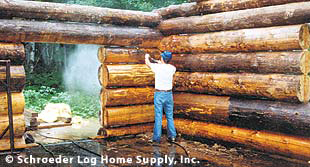How do I clean my logs?
1. Exterior Cleaning Lightly cob blast, sandblast, sand, or pressure wash (the most often used method) new logs.
Why should you power wash new logs? As is true for most any job, proper preparation is as important as doing the actual job. This is certainly true for properly preparing the exterior surface of logs before applying stain to them. The leftover mill glaze* must be removed, and the surface should be slightly roughened to allow the stain to penetrate as deeply as possible. *Mill glaze is the stain-repelling film leftover from shaping the logs in the processing mill. One way to understand the importance of this step is to realize that it is very rare to ever have any failure of a coating applied to the cut end of a log. The log end is extremely rough in texture, and the coating has ample opportunity to penetrate and establish optimum adhesion. The goal of power washing is to stimulate the texture without dramatically affecting the log’s appearance.
When pressure washing, we suggest you used one of these cleaning agents if you will be applying either a water-based or oil-based finish:
CPR,
New Log Prep,
X-180 Weathered Wood Restorer, or Bleach & Water: A mixture of one part household bleach and five parts water, plus one tablespoon
TSP (Tri-sodium phosphate) per gallon (optional). Note: Log Maintenance Wash is best for cleaning logs that already have a finish.
Bleach is a corrosive chemical irritant that can damage surfaces like skin and fabric. Never mix bleach and ammonia for any reason, the results can be fatal. Also, it is not recommended to mix bleach with other household cleaners that may contain ammonia or to mix bleach with vinegar. Vinegar and bleach will create a chlorine gas that is a toxic health risk.
Do not use household bleach as a cleaning agent for deck lumber that was treated with CCA (chromated copper arsenate) or more commonly known as "pressure treated lumber". This type of treated lumber was removed from the market by 2003. If your deck or landscaping timbers were made from this lumber, use an oxygen bleach like KleenStart Wood Cleaner instead of household chlorine bleach. Chlorine bleach when combined with CCA forms highly toxic chromium and arsenic compounds.
Apply cleaning agents from the bottom and work up. This will avoid streaking of the logs. Allow agent to stand 10-15 minutes before power washing. Rinse thoroughly. Allow to dry 3-7 days depending on drying conditions before applying stain.
Be sure to thoroughly rinse the cleaning agent and allow the log surfaces to completely dry before applying a finish.
After cleaning, you will notice a woody pulp on the surface. This can be removed by hand with a 3-M stripping pad or a quicker method is using an
Osborn Buffing Brush on an angle grinder or car buffer. Usually two brushes are required for a house. If you did not use a sap-stain control, you may notice sap-stain, a blue, red, or brown coloration deep in the wood. These are permanent stains and unfortunately can not be removed.
2. Interior Cleaning on the inside may be more messy than on the outside, if the house is already furnished. A general dusting may work, but to actually clean the logs, a sponge saturated with a bleach and water combination may be used. The logs will need to be rinsed, hence the messiness. A trough could be built to catch any of the dripping water when rinsing, or use another sponge with plain water. Otherwise, just a light sanding is necessary.
 Some friends of mine, a young couple, are looking at purchasing a log home in the area. It's a nice home with a very appealing design. Unfortunately, it has a few issues to take care of before closing. Some of the log ends have deteriorated and will need repair. Many of the ends are sticking out far, even past the eaves. It's a perfect example of how gutters, log eaves, well-stained log ends, and caulking on upward-facing checks could have gone a long way to prevent headaches down the road. The existing problems are repairable, but protecting the log ends better would have prevented them altogether.
Some friends of mine, a young couple, are looking at purchasing a log home in the area. It's a nice home with a very appealing design. Unfortunately, it has a few issues to take care of before closing. Some of the log ends have deteriorated and will need repair. Many of the ends are sticking out far, even past the eaves. It's a perfect example of how gutters, log eaves, well-stained log ends, and caulking on upward-facing checks could have gone a long way to prevent headaches down the road. The existing problems are repairable, but protecting the log ends better would have prevented them altogether.


